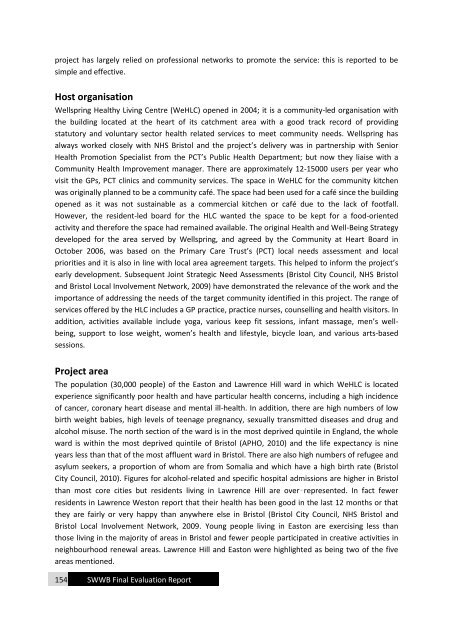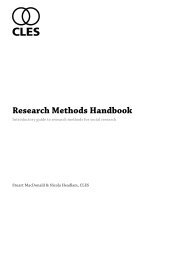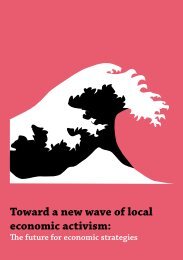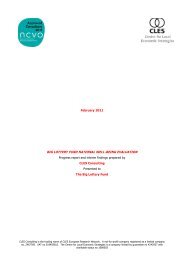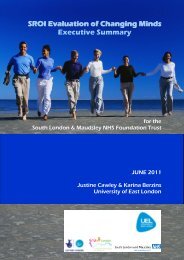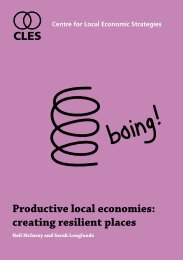Aim and objectives of the report - CLES
Aim and objectives of the report - CLES
Aim and objectives of the report - CLES
- No tags were found...
Create successful ePaper yourself
Turn your PDF publications into a flip-book with our unique Google optimized e-Paper software.
project has largely relied on pr<strong>of</strong>essional networks to promote <strong>the</strong> service: this is <strong>report</strong>ed to besimple <strong>and</strong> effective.Host organisationWellspring Healthy Living Centre (WeHLC) opened in 2004; it is a community-led organisation with<strong>the</strong> building located at <strong>the</strong> heart <strong>of</strong> its catchment area with a good track record <strong>of</strong> providingstatutory <strong>and</strong> voluntary sector health related services to meet community needs. Wellspring hasalways worked closely with NHS Bristol <strong>and</strong> <strong>the</strong> project’s delivery was in partnership with SeniorHealth Promotion Specialist from <strong>the</strong> PCT’s Public Health Department; but now <strong>the</strong>y liaise with aCommunity Health Improvement manager. There are approximately 12-15000 users per year whovisit <strong>the</strong> GPs, PCT clinics <strong>and</strong> community services. The space in WeHLC for <strong>the</strong> community kitchenwas originally planned to be a community café. The space had been used for a café since <strong>the</strong> buildingopened as it was not sustainable as a commercial kitchen or café due to <strong>the</strong> lack <strong>of</strong> footfall.However, <strong>the</strong> resident-led board for <strong>the</strong> HLC wanted <strong>the</strong> space to be kept for a food-orientedactivity <strong>and</strong> <strong>the</strong>refore <strong>the</strong> space had remained available. The original Health <strong>and</strong> Well-Being Strategydeveloped for <strong>the</strong> area served by Wellspring, <strong>and</strong> agreed by <strong>the</strong> Community at Heart Board inOctober 2006, was based on <strong>the</strong> Primary Care Trust’s (PCT) local needs assessment <strong>and</strong> localpriorities <strong>and</strong> it is also in line with local area agreement targets. This helped to inform <strong>the</strong> project’searly development. Subsequent Joint Strategic Need Assessments (Bristol City Council, NHS Bristol<strong>and</strong> Bristol Local Involvement Network, 2009) have demonstrated <strong>the</strong> relevance <strong>of</strong> <strong>the</strong> work <strong>and</strong> <strong>the</strong>importance <strong>of</strong> addressing <strong>the</strong> needs <strong>of</strong> <strong>the</strong> target community identified in this project. The range <strong>of</strong>services <strong>of</strong>fered by <strong>the</strong> HLC includes a GP practice, practice nurses, counselling <strong>and</strong> health visitors. Inaddition, activities available include yoga, various keep fit sessions, infant massage, men’s wellbeing,support to lose weight, women’s health <strong>and</strong> lifestyle, bicycle loan, <strong>and</strong> various arts-basedsessions.Project areaThe population (30,000 people) <strong>of</strong> <strong>the</strong> Easton <strong>and</strong> Lawrence Hill ward in which WeHLC is locatedexperience significantly poor health <strong>and</strong> have particular health concerns, including a high incidence<strong>of</strong> cancer, coronary heart disease <strong>and</strong> mental ill-health. In addition, <strong>the</strong>re are high numbers <strong>of</strong> lowbirth weight babies, high levels <strong>of</strong> teenage pregnancy, sexually transmitted diseases <strong>and</strong> drug <strong>and</strong>alcohol misuse. The north section <strong>of</strong> <strong>the</strong> ward is in <strong>the</strong> most deprived quintile in Engl<strong>and</strong>, <strong>the</strong> wholeward is within <strong>the</strong> most deprived quintile <strong>of</strong> Bristol (APHO, 2010) <strong>and</strong> <strong>the</strong> life expectancy is nineyears less than that <strong>of</strong> <strong>the</strong> most affluent ward in Bristol. There are also high numbers <strong>of</strong> refugee <strong>and</strong>asylum seekers, a proportion <strong>of</strong> whom are from Somalia <strong>and</strong> which have a high birth rate (BristolCity Council, 2010). Figures for alcohol-related <strong>and</strong> specific hospital admissions are higher in Bristolthan most core cities but residents living in Lawrence Hill are over‐represented. In fact fewerresidents in Lawrence Weston <strong>report</strong> that <strong>the</strong>ir health has been good in <strong>the</strong> last 12 months or that<strong>the</strong>y are fairly or very happy than anywhere else in Bristol (Bristol City Council, NHS Bristol <strong>and</strong>Bristol Local Involvement Network, 2009. Young people living in Easton are exercising less thanthose living in <strong>the</strong> majority <strong>of</strong> areas in Bristol <strong>and</strong> fewer people participated in creative activities inneighbourhood renewal areas. Lawrence Hill <strong>and</strong> Easton were highlighted as being two <strong>of</strong> <strong>the</strong> fiveareas mentioned.154 SWWB Final Evaluation Report


